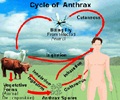As US investigators were closing in on him, a top anthrax expert has committed suicide.
Bruce E Ivins, a top US anthrax expert, died Tuesday at Frederick Memorial Hospital after ingesting a massive dose of prescription Tylenol mixed with codeine.
He had committed suicide when the federal investigators were closing in on him in connection with the 2001 anthrax attacks. Just as the Justice department was about to file charges against Ivins, he chose to end his life to avoid ignominy, newspapers said.He might have stood to gain financially from the nationwide scare of 2001 for he had patented an anthrax vaccine, newspapers reported.
The anthrax mailings, which killed five people, shook the nation just weeks after the terror attacks of September 11, 2001.
Of the five people killed by the mailings, two worked for the U.S. Postal Service in the Washington, D.C., area; one was a photo editor in Palm Beach County, Fla.; another was a hospital supply provider in New York City; and the last known victim was a 94-year-old woman in Connecticut.
There have been no arrests in the case, which started after someone sent letters laced with spores of deadly anthrax to congressional offices and several news organizations. Among those who died were two postal workers. Two contaminated letters were sent to senators, exposing 30 staffers.
Ironically only recently the government had reached a $ 5.82 million out-of-court settlement with another scientist, Steven J Hatfill, whom it had named a “person of interest.”
Advertisement
The 62-year-old Ivins had worked for the last 18 years worked with the U.S. Army Medical Research Institute of Infectious Diseases (USAMRIID), the government's elite bio-defense research laboratories situated in Ft. Detrick, Maryland. He had played a central role in research to improve anthrax vaccines by preparing anthrax formulations used in experiments on animals.
Advertisement
Ivins himself first attracted the attention of Army officials because of anthrax contaminations that he had failed to report for five months. In sworn oral and written statements to an Army investigator, Ivins said that he had erred by keeping the episodes secret -- from December 2001 to late April 2002. He said he had swabbed and bleached more than 20 areas that he suspected were contaminated by a sloppy lab technician.
"In retrospect, although my concern for biosafety was honest and my desire to refrain from crying 'Wolf!' . . . was sincere, I should have notified my supervisor ahead of time of my worries about a possible breach in biocontainment," Ivins told the Army.
"I thought that quietly and diligently cleaning the dirty desk area would both eliminate any possible [anthrax] contamination as well as prevent unintended anxiety at the institute."
The Army chose not to discipline Ivins regarding his failure to report the contamination. Officials said that penalizing Ivins might discourage other employees from voluntarily reporting accidental spills of "hot" agents.
But Ivins' recollections should have raised serious questions about his veracity and his intentions, according to some of those familiar with the investigation. For instance, although Ivins said that he swabbed areas near and within his personal office, and bleached surfaces to kill any spores, and that some of the swabs tested positive, he was vague about what should have been an essential next step.
On Friday, colleagues and critics of Ivins pondered the mystery within the mystery: If Ivins did it, why?
One former senior official with Ivins' employer, the U.S. Army Medical Research Institute of Infectious Diseases, whom the FBI questioned at length about Ivins, said he believed his former colleague wanted more attention -- and resources -- shifted to biological defense.
"It had to have been a motive," said the former official, who suspects that Ivins was the culprit. "I don't think he ever intended to kill anybody. He just wanted to prove 'Look, this is possible.' He probably had no clue that it would aerosolize through those envelopes and kill those postal workers."
Besides Los Angeles Times also reports that Ivins is listed as a co-inventor on two patents for a genetically engineered anthrax vaccine.
A multi-million dollar contract was awarded at one stage, only to be terminated because of problems in supply schedule. If it had stood, Ivins would have made thousands of dollars for himself.
Ivins also was listed as one of two inventors of another biodefense-related product that has won federal sponsorship.
According to their still-pending application for a U.S. patent, the inventors hoped the additive would bolster certain vaccines' capacity to prevent infections "from bioterrorism agents."
Soon after the government's settlement with Hatfill was announced June 27, Ivins began showing signs of serious strain.
One of his longtime colleagues said that Ivins, who was being treated for depression, indicated to a therapist that he was considering suicide.
Soon thereafter, family members and local police officers escorted Ivins from USAMRIID, where his access to sensitive areas was curtailed, the colleague said.
Ivins was committed to a facility in Frederick for treatment of his depression. Only on July 24, he was released from the facility.
Source-Medindia
GPL/L









